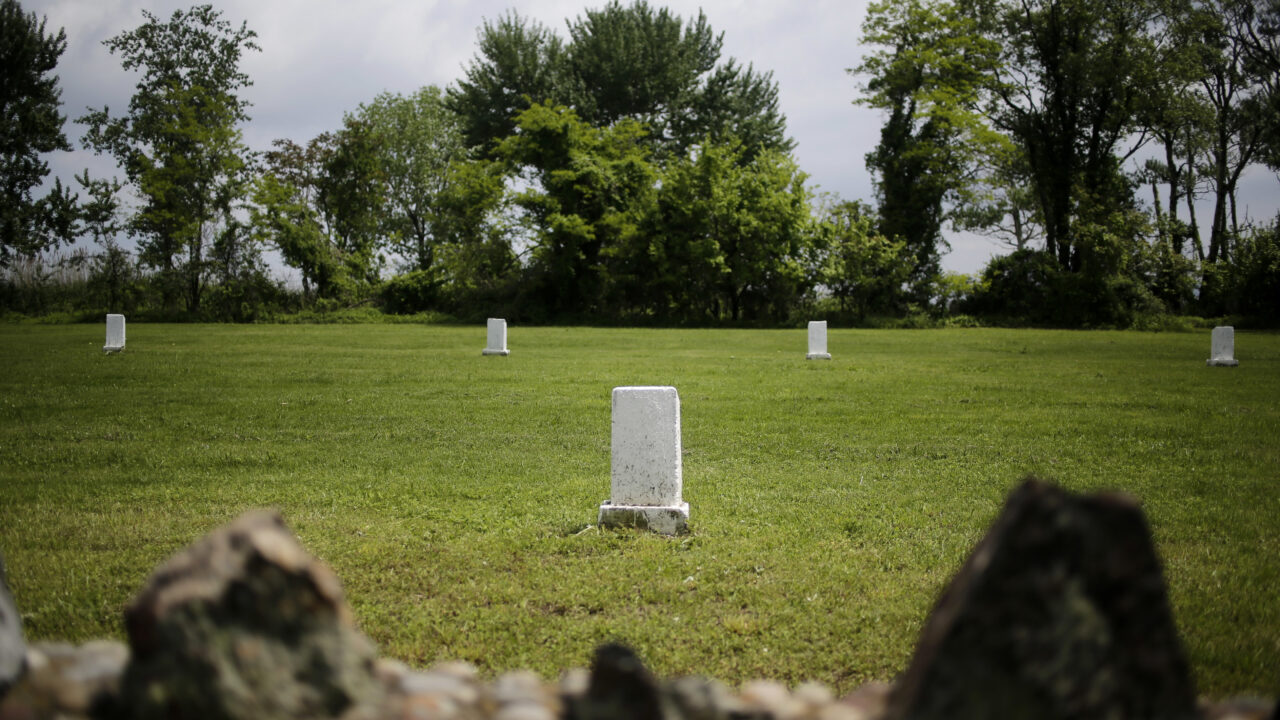NYC Continues To Add to Its Little-Known Mass Grave Site
Critics say the city is likely to keep using Hart Island as a cemetery of last resort, despite soliciting public input on its future. In this 2018 photo, white markers, each indicating a mass grave of 150 people, are displayed on Hart Island in New York. (AP Photo/Seth Wenig)
In this 2018 photo, white markers, each indicating a mass grave of 150 people, are displayed on Hart Island in New York. (AP Photo/Seth Wenig)
The New York City Human Resources Administration has increased the number of bodies in each of the city’s mass graves on Hart Island in recent months, with as many 200 caskets in each trench. That’s up from what had been a standard 150 caskets per trench, as the number of burials there went up significantly last year.
An urban planner for the city’s Department of Parks and Recreation, which manages Hart Island jointly with HRA, confirmed the increased number of bodies per grave in an exchange with advocates from the Hart Island Project, a nonprofit organization that maintains an online database of the people buried there since 1980 and a map of their grave locations, according to a June 25 email shared with The City.
The 100-plus-acre island in the Long Island Sound, just east of City Island, has served as the city’s burial ground since 1869 for the bodies of unclaimed New Yorkers and those whose families couldn’t afford funeral arrangements. More than a million people are buried there, making it one of the largest burial grounds in the country.
After years of advocacy from the Hart Island Project and others, a city law passed in 2019 took the island out of the jurisdiction of the Department of Correction, which had long relied on inmate labor to oversee burials there. The land was then turned over to the Parks Department and burials to the Human Resources Administration.
More than a million people are buried on Hart Island, making it one of the largest burial grounds in the country.
But as the COVID-19 pandemic ravaged New York City in 2020, burials on the island more than doubled, to 2,743 from 1,138 in 2019, according to HRA data. After dropping down to just over 1,300 in both 2021 and 2022 — just below a pre-pandemic peak of 1,329 burials recorded in 1988 in the midst of the AIDS crisis — the number of burials shot up again in 2023, to 1,979.
Melinda Hunt, the president of the Hart Island Project, said it was deeply troubling that each newly filled trench now holds 50 more corpses, and that the shift — previously unreported — seemed to fly in the face of a push to end mass burials there. The city is developing a master plan for the isolated and difficult-to-visit island cemetery as a city park.
While the city is in the process of soliciting public input on the future of the island, expanding mass graves suggests it has already decided to continue with a burial system that has been in place since just after the Civil War ended, said Hunt.
While the island also served at various points as a jail, a homeless shelter and a Nike missile installation, its last inhabited structures were abandoned in 1977. Ferries now visit two weekends each month for visits from up to 70 people whose loved ones are buried there. There are also two tours a month conducted by urban park rangers, with limited slots open to the public.
“Nobody’s constituents want to be buried in a mass grave,” Hunt said. “That just isn’t something that is culturally acceptable to anybody.”
Neha Sharma, a spokesperson for HRA, said the agency has “taken critical steps to reform the delivery of burial services, identify and honor burial plots that had gone unmapped for decades, modernize tracking mechanisms and outdated systems of record to make it easier for the public to reliably find where their loved ones are buried.”
‘I can’t do this’
Gloria James, 30, recalled her first visit there to visit the burial site of her 81-year-old father, Arthur James, a retired Parks employee who died last August of a heart attack. He was buried there because she couldn’t afford funeral arrangements, and the mass grave in which he was placed was still open to the air.
“The ground wasn’t even sealed yet. I was able to see other caskets in the ground. I was just like, ‘I can’t do this,’” she said, adding no one had warned her about the mass graves on the island. “I was thinking he was gonna have an individual tombstone.”
On a subsequent visit, Parks employees who guide family members to gravesites took her to one location where she wept while mourning her father: “He was an amazing dad, sometimes my mom got jealous. I put him on the highest pedestal.”
While the island also served at various points as a jail, a homeless shelter and a Nike missile installation, its last inhabited structures were abandoned in 1977.
But about an hour into James’ visit, Parks Department workers studied a map and realized they had taken her to the wrong location, she recalled, and shepherded her to another one.
“After that, I was kind of like, ‘Well, I’m just ready to go,’ I was over it,” James said. “It was already hard for me to be there.”
Gregg McQueen, a spokesperson for the Parks Department, confirmed the mix-up and said that there had been a typo listing the wrong grave number. A supervisor later called James to apologize, McQueen said.
Despite that confusion, James has returned to what she now understands to be her father’s final resting place, which is close to the waterfront.
“It’s really beautiful and peaceful,” she said. “When I go there, I feel at peace.”
Still, she said, “I want everybody to have an individual grave. … I really haven’t been able to properly grieve because of that.”
‘A fourth level of caskets’
The recent shift to putting more corpses in each burial points to how real-estate pressures in New York continue after death and below ground.
A 2022 study commissioned by the city suggested that the island could run out of burial space as soon as 2030. At that time, the city buried 150 caskets in each 60-by-14-inch-wide trench, with three layers of coffins stacked on top of each other in a grid two caskets wide and 25 caskets long.
The study recommended using additional land where buildings once stood, as well as increasing the number of caskets per trench by adding “a fourth level of caskets” in order to extend the use of Hart Island as a burial ground for an additional 61 years.
The recent shift to putting more corpses in each burial points to how real-estate pressures in New York continue after death and below ground.
Sharma did not confirm or deny the size of mass graves had increased but said the city is implementing some of the study’s findings while working to extend capacity on Hart Island.
The Hart Island Project has been pushing for City Hall to consider its own competing study, conducted with the help of landscape architects at Ohio State University, on the feasibility of switching to individual gravesites.
That plan would entail reusing individual gravesites after several decades with a tactic called “lift and deepen,” where a person’s remains are eventually exhumed and placed into a mortuary box at the foot of the original grave. A new set of remains could then be buried there. This would enable New York to continue using Hart Island for burials in perpetuity, the group says.
The city’s study made a passing reference to the lift-and-deepen method, which has been used in locations like South London’s 168-year-old Camberwell Old Cemetery. But it quickly concluded the idea wasn’t “a natural fit for Hart Island,” citing “significant archaeological excavation and expertise” required to do that work properly.
Hunt, on the other hand, argues that the cost would be similar to mass burials while making it easier to relocate remains if they need to be exhumed — which happens about 50 times a year. And that approach, she says, would also make it safer for visitors to navigate, because mass graves can create unpredictable terrain that can cave in.
Most importantly, she added, individual gravesites matter to people visiting their loved ones.
Hunt has been meeting with elected officials hoping to drum up support for changes to city law that would halt mass burials and require HRA to collect GPS locations for each individual buried on Hart Island. Those changes would also require HRA to develop a plan for green burials on the island, with more biodegradable coffins and limited embalming chemicals. There are currently no green burial options within the five boroughs.
Those ideas have received some preliminary interest in the City Council.
“The ideas that they were proposing about maybe recycling the space are interesting to me, and I would love to be able to debate that in a hearing just to be able to get a little bit more perspective from folks,” Councilmember Diana Ayala (D-Manhattan/the Bronx), who met with the Hart Island Project in July, told The City.
Ayala said she was familiar with the “lift and deepen” practice of recycling gravesites after a number of years, adding that her family did that their burial plot in Puerto Rico. “We have eight people in that one little plot. It makes sense environmentally and also capacity wise.”
“It’s not an unusual concept,” she added.
“People go to these graves and they don’t really believe that the City of New York knows where their relative is buried.”
Another ongoing concern for Hunt is the accuracy of the records kept by New York City on where bodies are buried. Hunt’s group — which obtained GPS coordinates for mass graves for the past decade through Freedom of Information Law requests from the Department of Correction — has had recent requests denied by the Human Resources Administration, she said.
Sharma said the city still collects GPS coordinates for mass graves but hasn’t made more recent information available because it’s in the process of upgrading systems.
Hunt said she continues to have concerns about the city’s ability to locate specific gravesites and is pushing for legislation that would require GPS coordinates for each individual buried there.
“If you lose a body, it’s a million-dollar lawsuit,” Hunt said. “People go to these graves and they don’t really believe that the City of New York knows where their relative is buried.”
Katie Honan contributed reporting.
Your support matters…Independent journalism is under threat and overshadowed by heavily funded mainstream media.
You can help level the playing field. Become a member.
Your tax-deductible contribution keeps us digging beneath the headlines to give you thought-provoking, investigative reporting and analysis that unearths what's really happening- without compromise.
Give today to support our courageous, independent journalists.








You need to be a supporter to comment.
There are currently no responses to this article.
Be the first to respond.